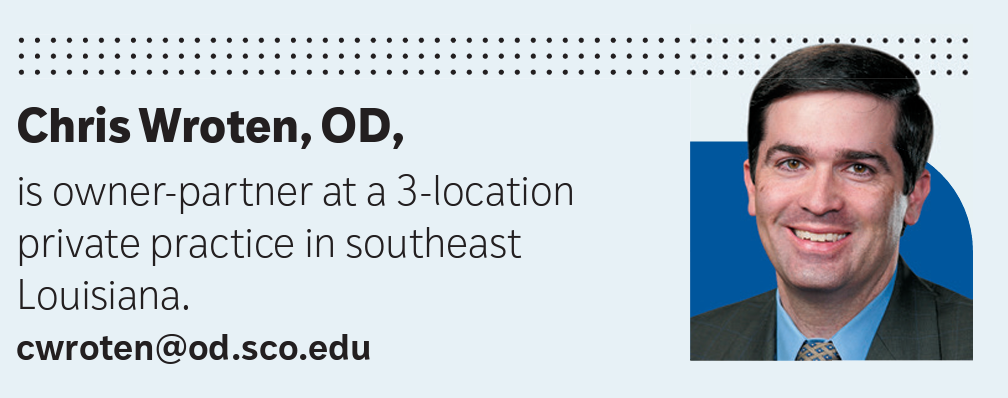Happy accidents vs planning for success: part 1
An OD's advice on ow to avoid disorder and build a thriving optometry practice.


Growing up, my mom was a teacher and talented artist, and at a relatively early age, she enrolled my sisters and me in art classes. Perhaps it was for that reason that I became enamored with a TV show I came across on our local PBS affiliate called, "The Joy of Painting” with Bob Ross.
Each episode started with a blank canvas, and during the show, Ross walked viewers through painting techniques, providing suggestions as he painted what was usually a landscape.
As he decided where on the canvas to place a tree or stream or rock from the picture in his mind, he encouraged aspiring artists to make their own decisions, saying, “We don’t make mistakes—just happy little accidents!” The end result was fascinating.
Related: 3 practice hacks for success with patients
Although “winging it” on a canvas may produce artistic results, doctors must be more intentional to maximize their practice’s success. Rather than hoping for “happy little accidents,” doctors must develop tried-and-true business habits.
Paraphrasing the second law of thermodynamics from physics, disorder eventually increases in any system that is left to itself.
So how can we avoid disorder and achieve success in the business side of our practices?
Strategic planning has been successfully used by large corporations and nonprofit associations to do just that for years. It involves systematically analyzing where the business is and where it can go. What follows is a strategic planning process that can be used for optometry practices.
Whom to include?
Effective strategic planning requires the involvement of multiple individuals with different backgrounds and from different areas of the practice (eg, front-office personnel, technicians, optical staff, billing department, etc) on the strategic planning committee. But if the committee is too large, its effectiveness is often hampered.
Ideally, the strategic planning committee would be no larger than 7 to 10 individuals, at most.
A chair or moderator should be named, with consideration given to hiring someone from outside the practice who specializes in strategic planning to guide the process, although this may not be necessary.
Additionally, someone besides the chair/moderator should be named as the “secretary” of the committee, tasked with taking notes and capturing ideas at meetings.
How to proceed?
After naming the committee, the chair/moderator should set clear goals and timelines (eg, announce 3 committee meetings, with starting and ending times, with the goal of planning for the next 3-5 years).
For strategic planning, in-person meetings are still preferable, but they can be accomplished virtually using the various platforms we’ve all used during the pandemic.
Related: 5 lessons I learned from a trip to the ER
After each meeting, action items, timelines for follow-up on them, and those responsible for doing them should be shared with the entire committee. The chair/moderator is also responsible for ensuring each meeting starts and ends on time and for keeping things moving during the meetings—without shutting down productive discussion that may organically evolve.
Meeting No. 1: the brainstorming session
To facilitate the process, the chair/moderator should encourage all planning committee members to begin brainstorming ideas for improving the practice at least 1 week prior to the meeting. Committee members can also solicit input from other noncommittee staff within their departments. At the beginning of the meeting, ground rules should be set by the chair/moderator:
» Everyone has an equal voice, must contribute, and deserves respect.
» Keep comments to yourself on other’s suggestions (ie, no comments from the peanut gallery) to avoid stifling discussions.
» No area of the practice is off-limits.
» No idea is too big/too expensive to consider at this stage because ideas that may not be feasible can lead to other ideas that are.
» All ideas should be captured by the secretary; they can be grouped by topic (eg, capital investments, marketing, optical, procedures, staff training, equipment, etc) after this meeting or during the following meeting.
Various brainstorming techniques like SWOT (strengths, weaknesses, opportunities, and threats) analysis can help generate ideas, which creates an opportune time to revisit/develop a practice’s mission and vision statement, if desired (discussed in my next column).
Related: Artificial intelligence might be the future of practice management
Meeting No. 2: the pare-down session
Taking all ideas from the brainstorming session, the secretary should group them by topic and, with committee input, assign each item a/an:
» estimated length of time to implement, eg, short term (< 12 months), midterm (1-3 years), or long term (> 3 years);
» projected cost to implement; and
» predicted return on investment.
Once these data are in hand, the committee should vet each idea and assign it a priority:
» A = high priority/start now
» B = medium priority/to be done as fund2 ing allows
» C = low priority/needs additional consideration
» D = nonstarter/not feasible
Once each idea/suggestion from the brainstorming meeting has these additional considerations attached, the committee should pare them down and present those with an A or B priority to the practice owner(s) for review.
Meeting No. 3: the wrap-up session
This final committee meeting is typically the shortest and involves addressing any follow-up the owner(s) may ask for regarding the committee proposals. If additional information for decision-making purposes has been requested on any items, it should be provided, and the owner(s) should then either sign off on which proposals to implement and assign project timelines and responsibilities for implementation or authorize the chair/moderator to do so. Individual project committees could be convened at this point to take over implementation, depending on the size and scope of what’s to be done.
It then becomes crucial that ownership/management holds those responsible for implementing changes accountable and that the strategic plan is reviewed at least annually.
Plan for success
Strategic planning is a great way to keep staff engaged and vested in the practice’s success, and it is a worthwhile exercise to do every 3 to 5 years.
Here’s to lots of happy accidents in painting and to even more “intentional successes” in your practice.

Newsletter
Want more insights like this? Subscribe to Optometry Times and get clinical pearls and practice tips delivered straight to your inbox.